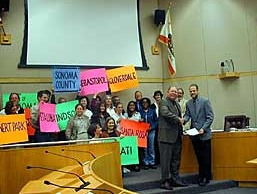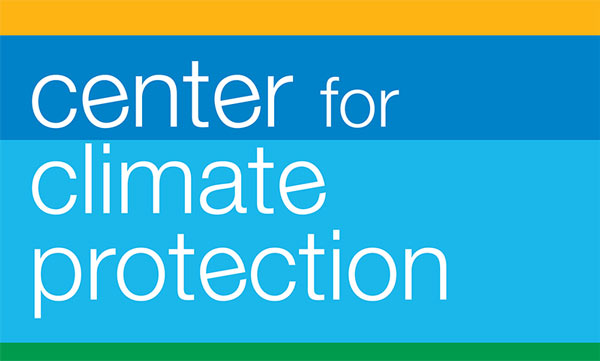In 2001, Ann Hancock and Mike Sandler responded to a call for action from the Cities for Climate Protection program. Under the motto of “local action moves the world,” the program works with local governments to commit to greenhouse gas reduction goals and create plans for achieving them. Ann and Mike believed that if the initiative were going to succeed, places like their home region – Sonoma County, CA – had to set the bar. The Center for Climate Protection (then called the Climate Protection Campaign) was born.
Ann and Mike set a goal of getting the County and all nine of its cities committed to Cities for Climate Protection by 2002. Climate change was not a top issue at the time, and nowhere in the country had 100 percent of an area’s cities committed to emission reduction. They achieved their goal four months earlier than they’d expected.

With the County and all nine Cities on board, the Center began calculating the emissions for all local government operations and the community at large. Emission inventories for local government operations were completed in September 2003 and for the community as a whole in 2005.
The next step was to set a target for reducing emissions. The Center convened a one-day workshop with representatives from business, youth, government, and the community, from each of the 10 local governments to determine the goal. The resulting recommendation was to set a target to reduce Sonoma County’s emission levels 25 percent below 1990 levels by 2015, the boldest target in the U.S. at the time. All ten local governments adopted the 25 percent reduction target by resolution.
From there, the Center for Climate Protection developed the Community Climate Action Plan, a blueprint for achieving emission reduction targets in a cost-effective and technically-feasible manner. The plan was developed over several years with the participation of 50 representatives from government, business, and community groups, along with numerous technical consultants. A comprehensive plan, it weighed in at 570 pages.
The Climate Action Plan kicked off the Center’s efforts to implement solutions intersecting every part of our fossil-fuel-based economy – transportation, land use, buildings, solid waste, agriculture and forestry. In 2005, the Center conducted analysis revealing that Community Choice Energy is the most powerful, cost-effective, local solution for significantly reducing greenhouse gas emissions. To that end, the Center advocated for the creation of the state’s second Community Choice Energy program (the first was in Marin) and in May 2014, Sonoma Clean Power which began serving customers. The Center is actively helping other communities take similar action, while incubating other successful Sonoma County programs that can be implemented across the state and beyond. To make genuine strides in climate action, it needs to make economic sense, and Sonoma County is taking the lead in modeling that what makes environmental sense also makes economic sense.
To that end, the Center is also a long-time advocate of the “cap and dividend” approach to state and national carbon regulation. In California, the Center helped persuade the Market Advisory Committee to pass the Global Warming Solutions Act of 2006 (AB 32) to partially include a dividend approach. The Center will continue promoting dividends in the next stages of the carbon market. If the money from carbon pricing goes back to families, the carbon price can escalate enough to stimulate requisite shifts in how we power our economy, and how we return carbon emissions to safe levels.
“Local action moves the world” is the motto that inspired the creation of the Center for Climate Protection, and it still inspires our work. Working together, we can take the strides needed to tackle our global climate crisis.


